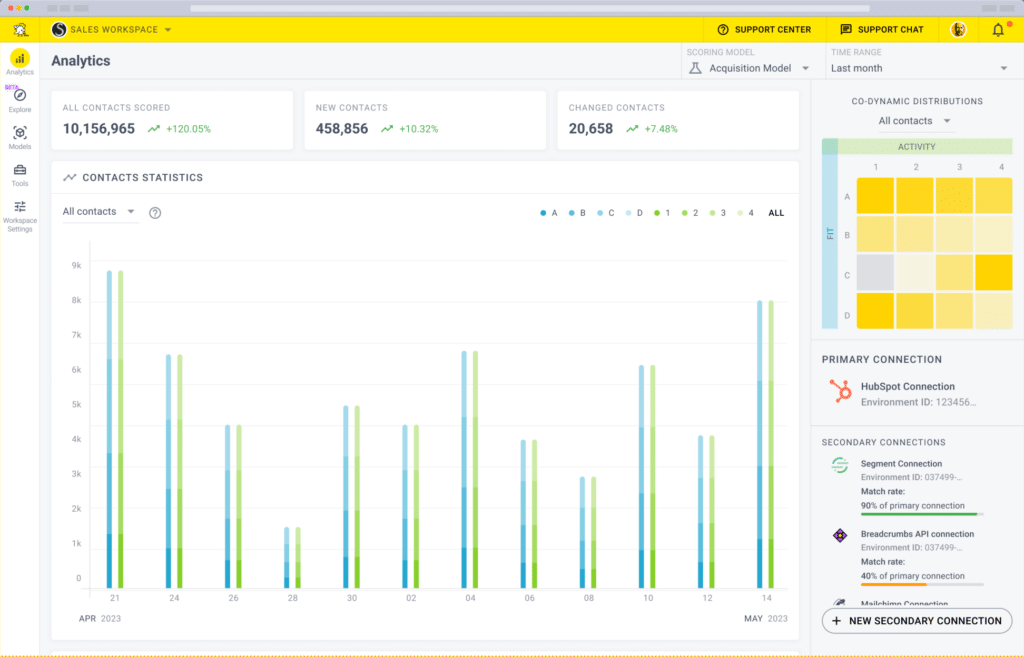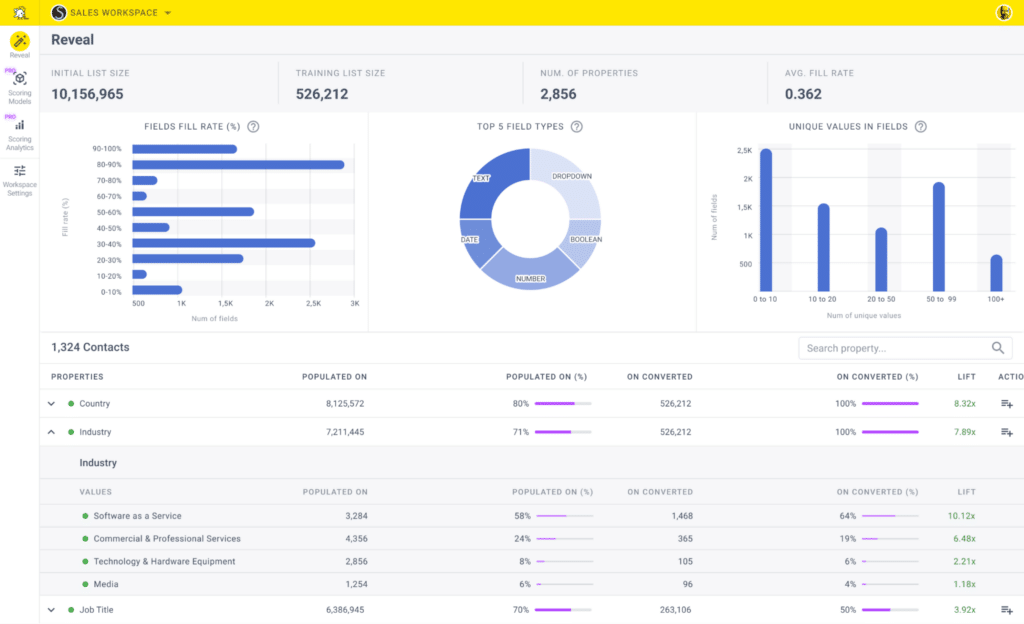Have you ever wondered about the quality of the data you input into your lead scoring system?
In one sentence, there’s a quote that could answer your question:
You only get out what you put in.
Let’s go further: data quality will be crucial when you start implementing and running a lead scoring process.
Setting up a good lead scoring model isn’t just about coming up with the right elements to score on and having the automated tools in place to ensure you can process them.
Rather, it’s about the quality of the data that you push into your lead scoring model to accurately identify and prioritize leads. Setting it right from the very beginning will give you an edge over your competition and speed up your revenue long-term.
In this article, we’ll analyze:
- how data quality will impact your lead scoring process
- how you can standardize the data you capture
- why you should only score the data you already have
Let’s get started.
The Impact of Data Quality on a Lead Scoring Process
Lead scoring is the process of ranking prospective customers that come your way by using a numerical system (usually a 1-100 point system) to determine which step of the customer value journey they are in.
With this information, you’ll know their sales-readiness (AKA, whether it’s the right time to hand off the lead to your sales team.)

If set up correctly, lead scoring will help you identify the intent of your prospects and prioritize the ones you really need to follow up with so you can close more deals.
In this sense, data quality and integrity become all the more important. You do not want your sales organization following up with the wrong prospective customers, and in particular those who are:
- Not ready to have a sales conversation with your team
- Not a good fit for what you offer
There is sometimes a misconception that more is better for leads. That’s where the concept of data quality comes into play.
While the volume of leads generated may look good on your quarterly review slides, the truth is that if you can’t programmatically qualify these leads because the quality of the data collected is not consistent (or the data is just flat out missing), then the lead is all for nothing.
If you want to make best friends with your sales team, then I would highly recommend focusing on data quality and NOT sending over every lead that takes a peek at your website or opens an email.
But how can you make sure that this doesn’t happen?
Let’s discuss three key practices you can put in place to ensure you’re putting quality data into your CRM, and that what you collect is clean, standardized, and scorable.
- Clean your data
- Standardize your data capture
- Score what you have data on
Clean your data
Sometimes people think they don’t have enough data to take advantage of a lead scoring system. Or they worry that their data isn’t organized, up to date, or synced enough to be helpful.
The reality is there’s no such thing as perfect data. Data is constantly in flux because your business is changing, the market is changing, your audience base is changing, and this is all happening with natural customer churn rates.
You don’t need a ton of data to inform lead scoring; you just need clean, relevant, and up-to-date data.
But how do you assess the health of your contact database and understand where collection and enrichment gaps exist to improve fill rates in all the right places?
Most teams struggle to understand the quality of the data in their CRM. (Which fields are populated or incomplete, what kind of data they contain, which data points correlate with revenue, and what their impact is).
Breadcrumbs Reveal will dive deep into your CRM or marketing automation software to quickly surface the state of your underlying data infrastructure, identify gaps in your data collection strategy, and highlight strong correlations between contact fields and their likelihood of becoming paying customers.
The best part of all? Breadcrumbs Reveal is completely free and you can get started in just three steps:
- Connect your data. Connect your lead and customer data with no-code connectors to popular tools such as HubSpot, Marketo, Salesforce, Mixpanel, Intercom, and more.
- Define Your Objective. Let us know what segment of contacts we should use to define success. i.e., all paying customers or paying customers on specific plans.
- Get Your Results. Get a detailed view of your data, how valuable it is, and where collection and enrichment gaps exist to improve fill rates.
Create your free Breadcrumbs Reveal account today and get a detailed view of your data, how valuable it is, and where collection and enrichment gaps exist so you can improve fill rates.
Standardize Your Data Capture
When thinking about how to increase the number of leads that flow into your marketing automation platform, there are three primary ways that data is pushed in:
- Form Submissions–forms on your website (i.e., contact forms) or landing pages that support your lead generation efforts.
- Inbound CRM Integration–data automatically imported into the MAP from your CRM.
- List Uploads–offline lists often provided from events, trade shows, or maybe even from your sales reps.
Data Quality on Form Submissions
With form submissions, you will often be capturing basic information on the customer (i.e., First Name, Last Name, and so on), but you also have the opportunity to find more persona-based information, like Title and Industry.
Moreover, to increase the quality of the data you collect, I’d recommend that your fields capture information consistently.
For example, data points like country, state, industry, and the number of employees can be set up in a drop-down menu with predefined values for the customer to choose from.
This will help to ensure consistency in the data flow back to the MAP, but also make the data much more reliable when it comes to scoring.
-
Lead Scoring vs Lead Nurturing: 7 Differences to Maximize Your Sales Funnel
Read more: Lead Scoring vs Lead Nurturing: 7 Differences to Maximize Your Sales FunnelManaging leads effectively means prospects move through the funnel efficiently, resulting in more conversions and…
Data Quality on Inbound CRM Integration
As for form submissions and data collected via inbound CRM integrations, it’s recommended that you use a consistent system to capture information.
In addition to that, in this case, you’d need the buy-in of different departments of your organization if you wish to ensure CRM data quality on the information collected in this way.
This type of data is often maintained and manipulated by the sales team, but the structure for how the data is captured (and, more importantly, the validation that ensures the data is captured correctly) will frequently be maintained by Sales Operations.
Data Quality on List Uploads
When it comes to list uploads, data quality gets a bit tricky. This is because they don’t always come from the same source, and every vendor will more than likely provide the data in a format that isn’t exactly how you want to capture it (nor is it standardized the same way from list to list.)
If you want to limit any manual cleanup, you may end up needing to do it when the data does not match. Setting up programs in your MAP to standardize the data can be very helpful.
In these programs, you will want to build a list of different variations of a value (think of VP, V.P. Vice President)–when your MAP finds one of these values, you can write the standardized value to another field. In this way, you won’t overwrite what the customer gave you originally in case you need it later.
Although trying to accommodate for every variation imaginable isn’t practical, finding the big offenders will go a long way in ensuring that your lead scoring program isn’t missing any critical data to score on.
While the hygiene of your email lists is part of another–broader–discourse, you can make sure the data quality of your email list is good by running it through an email verifier. (You can use ours for free!)
Score What You Have Data On
Verifying your data fields is often overlooked but is certainly important when defining how you weigh your lead scores as part of the overall model.
When reviewing the data you want to score against, you need to ensure that you have enough records that actually have the data you want to score against in the first place.
This sort of analysis can be difficult to perform manually. When using Breadcrumbs Reveal, on the other hand, we’ll show you which fields are the most populated and which ones are not (but are showing high correlations with current customers).

For example, if you discover that job title is a predictor of product fit, but you only have the data for a small portion of leads, you can prioritize integrating with a third-party enrichment provider such as Clearbit to improve the data you have for this segment.
It sounds simple, but let me give you an example. You wouldn’t believe how many scoring models I have seen that were set up to score a field like company revenue only to find that the information wasn’t being collected anywhere in the system or there were so few records in the database that had any value that the lead scores were effectively lower than what they could be if the scoring was done using a more complete data point.
When we started Breadcrumbs, we had this issue clear in our mind; this is why, when creating a scoring model in our platform, you’ll be able to score multiple fields in the same category.
An example? Let’s go back to the job title. If you have three different fields for job title, job role, and job function collected in different forms, you can score them all in a single category instead of creating three separate categories.
Now more than ever, time-to-revenue is extremely important for lead management. That is, you want to predict the time it will take a prospect to become a customer–all the way down from their first interaction to closing the deal.
Final Thoughts
Critical processes like lead scoring are the oil that helps your revenue engine go—the companies that are better able to qualify and quantify the engagement of their leads are the ones that will hit their quarterly revenue targets faster and more efficiently than others.
Lead scoring is an important process for any marketing and sales organization. It can streamline the way that marketing pre-qualified leads and make your sales team more efficient by following up with the right leads at the right time.
Ensuring that your data as part of your lead scoring program is consistent, clean, and scorable will ensure that all the work you have put into the automation actually does make your life easier.
In this post, we have analyzed how data quality impacts your lead scoring process, how you can (and should!) standardize the data you capture, and why you should score what you have data on.
Start improving the quality of the data you input in your lead scoring process. Create your free Breadcrumbs Reveal account today and get a detailed view of your data, how valuable it is, and where collection and enrichment gaps exist to improve fill rates.




